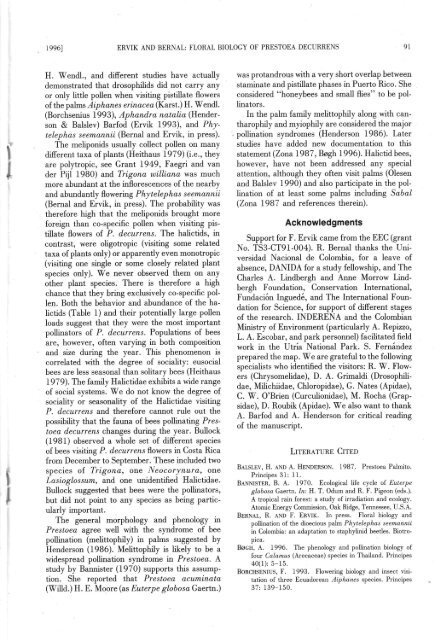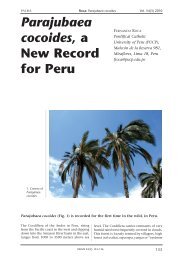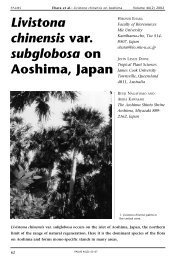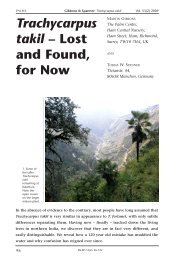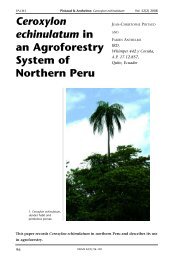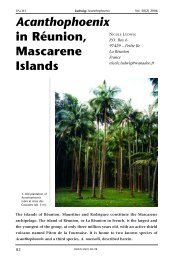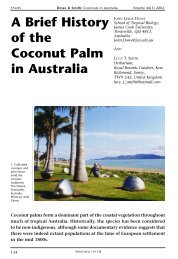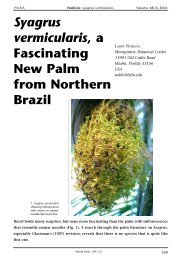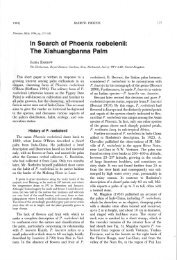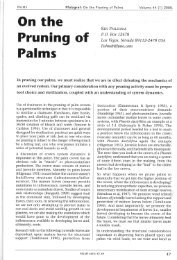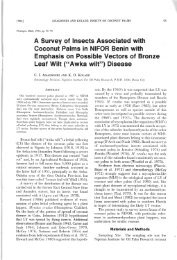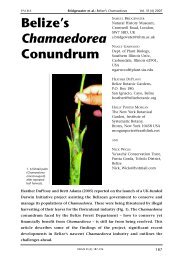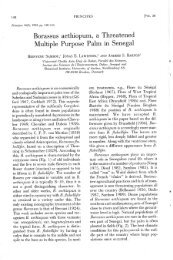Monoecious Palm Prestoea decurrens on - International Palm Society
Monoecious Palm Prestoea decurrens on - International Palm Society
Monoecious Palm Prestoea decurrens on - International Palm Society
Create successful ePaper yourself
Turn your PDF publications into a flip-book with our unique Google optimized e-Paper software.
19961<br />
ERVIK AND BERNAL: FLORAL BIOLOGY OF PRESTOEA DECURRENS<br />
9I<br />
I<br />
I<br />
H. Wendl., and different studies have actually<br />
dem<strong>on</strong>strated that drosophilids did not carry any<br />
or <strong>on</strong>ly little pollen when visiting pistillate flowers<br />
of the palmsliphanes erinacea(Karst.) H. Wendl.<br />
(Borchsenius I 993), Aphandra natalia (Henders<strong>on</strong><br />
& Balslev) Barfod (Ervik 1993), and. Phytelephas<br />
seemannii (Bernal and Ervik, in press).<br />
The melip<strong>on</strong>ids usually collect pollen <strong>on</strong> many<br />
different taxa of plants (Heithaus 1979) (i.e., they<br />
are polytropic, see Grant 1949, Eaegri and van<br />
der Pijl l9B0) and Trig<strong>on</strong>a williana was much<br />
more abundant at the inflorescences of the nearby<br />
and abundantly flowering Phytelephas seemannii<br />
(Bernal and Ervik, in press). The probability was<br />
therefore high that the melip<strong>on</strong>ids brought more<br />
foreign than co-specific pollen when visiting pistillate<br />
flowers of P. d.ecurrezs. The halictids, in<br />
c<strong>on</strong>trast, were oligotropic (visiting some related<br />
taxa ofplants <strong>on</strong>ly) or apparently even m<strong>on</strong>otropic<br />
(visiting <strong>on</strong>e single or some closely related plant<br />
species <strong>on</strong>ly). We never observed them <strong>on</strong> any<br />
other plant species. There is therefore a high<br />
chance that they bring exclusively co-specific pollen.<br />
Both the behavior and abundance of the halictids<br />
(Table l) and their potentially large pollen<br />
loads suggest that they were the most important<br />
pollinators of P. <str<strong>on</strong>g>decurrens</str<strong>on</strong>g>. Populati<strong>on</strong>s of bees<br />
are, however, often varying in both compositi<strong>on</strong><br />
and size during the year. This phenomen<strong>on</strong> is<br />
correlated with the degree of sociality: eusocial<br />
bees are less seas<strong>on</strong>al than solitary bees (Heithaus<br />
1979). The family Halictidae exhibits a wide range<br />
of social systems. We do not know the degree of<br />
sociality or seas<strong>on</strong>ality of the Halictidae visiting<br />
P. <str<strong>on</strong>g>decurrens</str<strong>on</strong>g> and therefore cannot rule out the<br />
possibility that the fauna of bees pollinating <str<strong>on</strong>g>Prestoea</str<strong>on</strong>g><br />
<str<strong>on</strong>g>decurrens</str<strong>on</strong>g> changes during the year. Bullock<br />
(I9Bl) observed a whole set of different species<br />
of bees visiting P. <str<strong>on</strong>g>decurrens</str<strong>on</strong>g> flowers in Costa Rica<br />
from December to September. These included two<br />
species of Trig<strong>on</strong>a, or'e Neocorynura, orre<br />
Lasioglossum, and <strong>on</strong>e unidentified Halictidae.<br />
Bullock suggested that bees were the pollinators,<br />
but did not point to any species as being particularly<br />
important.<br />
The general morphology and phenology in<br />
<str<strong>on</strong>g>Prestoea</str<strong>on</strong>g> agree well with the syndrome of bee<br />
pollinati<strong>on</strong> (melittophily) in palms suggested by<br />
Henders<strong>on</strong> (1986). Melittophily is likely to be a<br />
widespread pollinati<strong>on</strong> syndrome in <str<strong>on</strong>g>Prestoea</str<strong>on</strong>g>. A<br />
study by Bannister (1970) supports this assumpti<strong>on</strong>.<br />
She reported rhal <str<strong>on</strong>g>Prestoea</str<strong>on</strong>g> acumina'tcr'<br />
(Willd.) H. E. Moore (as Euterpe globosaGaertn.)<br />
was protandrous with a very short overlap between<br />
staminate and pistillate phases in Puerto Rico. She<br />
c<strong>on</strong>sidered "h<strong>on</strong>eybees and small flieso' to be pollinators.<br />
In the palm family melittophily al<strong>on</strong>g with cantharophily<br />
and myiophily are c<strong>on</strong>sidered the major<br />
- pollinati<strong>on</strong> syndromes (Henders<strong>on</strong> 1986). Later<br />
studies have added new documentati<strong>on</strong> to this<br />
statement (Z<strong>on</strong>a I9B7 ,Bagh L996). Halictid bees,<br />
however, have not been addressed any special<br />
attenti<strong>on</strong>, although they often visit palms (Olesen<br />
and Balslev 1990) and also participate in the pollinati<strong>on</strong><br />
of at least some palms including Sobol<br />
(Z<strong>on</strong>a I9B7 and references therein).<br />
Acknowledgments<br />
Support for F. Ervik came from the EEC (grant<br />
No. TS3-CT91-004). R. Bernal thanks the Universidad<br />
Naci<strong>on</strong>al de Colombia, for a leave of<br />
absence, DANIDA for a study fellowship, and The<br />
Charles A. Lindbergh and Anne Morrow Lindbergh<br />
Foundati<strong>on</strong>, C<strong>on</strong>servati<strong>on</strong> Internati<strong>on</strong>al,<br />
Fundaci6n Ingued6, and The Internati<strong>on</strong>al Foundati<strong>on</strong><br />
for Science, for support of different stages<br />
of the research. INDERENA and the Colombian<br />
Ministry of Envir<strong>on</strong>ment (particularly A. Repizzo,<br />
L. A. Escobar, and park pers<strong>on</strong>nel) facilitated field<br />
work in the Utria Nati<strong>on</strong>al Park. S. Fern6ndez<br />
prepaied the map. We are grateful to the following<br />
specialists who identified the visitors: R. W. FIowers<br />
(Chrysomelidae), D. A. Grimaldi (Drosophili<br />
dae, Milichiidae, Chloropidae), G. Nates (Apidae),<br />
C. W. O'Brien (Curculi<strong>on</strong>idae), M. Rocha (Grapsidae),<br />
D. Roubik (Apidae). We also want to thank<br />
A. Barfod and A. Henders<strong>on</strong> for critical readine<br />
of the manuscript.<br />
Lrrnnerune CIrro<br />
BALSLEv, H. ano A. HENDERSoN. 1987.. Presloea <str<strong>on</strong>g>Palm</str<strong>on</strong>g>ito.<br />
Principes 3I: II.<br />
BaNttsmn, B. A. 1970. Ecological life cycle of Euterpe<br />
globosa Gaerrn. In: H. T. Odum and R. F. Pige<strong>on</strong> (eds.).<br />
A tropical rain forest: a study of irradiati<strong>on</strong> and ecology.<br />
Atomic Energy Comissi<strong>on</strong>, Oak Ridge, Temessee, U.S.A.<br />
BERNAL, R. AND F. EnvIr. In press. Florhl biology and<br />
pollinati<strong>on</strong> of the dioecious palm Phytelephas seemannii<br />
in Colombia: an adaptati<strong>on</strong> to staphylinid beetles. Biotroplca.<br />
BocH, A. 1996. The phenology and pollinati<strong>on</strong> biology of<br />
Iorr Calamus (Arecaceae) species in Thailand. Principes<br />
40(l):5-I5.<br />
BoRCHSENIUS, F. 1993. Flowering biology and insect visitati<strong>on</strong><br />
of three Ecuadorean Aiphanes species. Principes<br />
37: I39-150.


